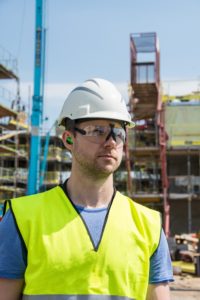Ear protection
A third of employees are not provided with hearing protection
Research conducted by Specsavers Corporate Eyecare has revealed that only 42% of employers in the UK provide overhead earmuffs to its employees.
 Businesses of all sizes across the UK took part in a survey to find out what type of hearing protection is provided for them. It looked at the types of hearing protection offered by companies in the UK. The findings were:
Businesses of all sizes across the UK took part in a survey to find out what type of hearing protection is provided for them. It looked at the types of hearing protection offered by companies in the UK. The findings were:
- Foam earplug 37%;
- Custom moulded earplug 26%;
- Ear canal caps 21%;
- Flanged earplug 20%;
- Integrated earmuff 18%;
- Banded earplug 17%.
Under the Control of Noise at Work Regulations 2005, it is the responsibility of employers to protect their employees from exposure to excessive noise and noise-induced hearing loss.
Professions such as aircraft ground control and construction workers are examples of jobs where employees are in risk of hearing damage/loss, if relevant protection is not provided. Noise above 85db (decibels) can cause permanent and disabling hearing damage, which cannot be reversed.
At a construction site, peak noise levels can reach 120db, for example a chainsaw’s average decibel can reach 106db-115db, which can significantly damage a construction worker’s hearing or permanently cause them hearing loss.
Jim Lythgow, Director of Strategic Alliances at Specsavers Corporate Eyecare, expressed that “employers themselves acknowledge that they are not providing the necessary hearing protection, and by failing to do so, they may be putting their employees’ hearing at risk.”
Ensuring that hearing protection is highlighted in Risk Assessments could save companies from getting a hefty fine if they also carry out what is stated.
Jim Lythgow said: ‘It is good to see that at least some hearing protection is being offered. Employers may feel that what they have provided is adequate, but it is important that needs and risks are fully assessed so that the most appropriate type of hearing protection is made available.’
According to the HSE, between 2015 and 2018, 23,000 workers suffered work related hearing problems, and insurance claims for workplace noise-induced hearing loss in the UK has increased 189% over the last three years.
Smart noise cancelling earplugs
 Although it is evident how crucial it is to have ear protection for protecting hearing damage, some employees also say that ear protection often compromises their ability to hear other things that could be hazardous in their environment. For instance, with the rise of electric vehicles on construction sites, the risk of accidents may increase due to not being able to hear the vehicles through ear protection.
Although it is evident how crucial it is to have ear protection for protecting hearing damage, some employees also say that ear protection often compromises their ability to hear other things that could be hazardous in their environment. For instance, with the rise of electric vehicles on construction sites, the risk of accidents may increase due to not being able to hear the vehicles through ear protection.
Science-based technology company, 3M, has sought to resolve this by introducing the Peltor Electronic Earplug, which enables ambient sounds to be heard by its wearer, while providing protection against louder sounds that could cause damage to their hearing. This improves the ability for employees to hear warning signs, approaching vehicles and crusical sounds emitted by machines and processes as well as communicating with nearby colleagues, thus reducing the need to remove ear protection.
The earplugs are designed for environments and professions such as metal workng, welding, construction, ship construction and maintenance companies.
Technical Specialist for the Personal Safety Division at 3M, a science-based technology company, said that “before the Peltor Electronic Earplug by 3M, workers often had to choose between protecting their hearing, or being able to communicate effectively and hear important sounds around them. By recognising this issue and leveraging its state-of-the-art technologies, 3M has delivered a solution that enables them to work smarter and more safely.”
Building Safety Group report
After an inspection in early 2019 which reviewed 10,000 independent sites, the Building Safety Group (BSG) ran a report which revealed that there is 25% increase in the number of noise infringements occurring on construction sites.
The HSE estimates that more than two million people in the UK are exposed to unacceptable levels of noise at work. Noise induced hearing loss is the second most common reason for employers’ liabilities claim for Occupational Health.
Technical Support Manager for BSG, Chris Chapmen commented, that “exposure to many different sources of noise on a construction site has a cumulative effect and can cause damage, even if a worker is only exposed to a single source for short periods of time.
Workers are also at risk if they have muffled hearing at the end of the day, even if it is better by the next morning. There is no need for hearing to be damaged, under the Control of Noise at Work Regulations 2005, employers have a duty to protect workers and take steps to reduce the risk”.
A third of employees are not provided with hearing protection
Specsavers Corporate Eyecare conducted a research to investigate if hearing protection is provided to employees by their employers.
Samah Ahmed
SHP - Health and Safety News, Legislation, PPE, CPD and Resources Related Topics
Company fined as worker has leg amputated
Aviation company fined after worker death at Heathrow Airport
Gogglebox star George Gilbey died after fall through skylight


